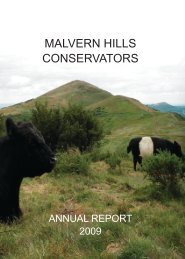Footpath degradation of the Malvern Hills - Malvern Hills Conservators
Footpath degradation of the Malvern Hills - Malvern Hills Conservators
Footpath degradation of the Malvern Hills - Malvern Hills Conservators
You also want an ePaper? Increase the reach of your titles
YUMPU automatically turns print PDFs into web optimized ePapers that Google loves.
Stephen Britnell<br />
<strong>Footpath</strong> <strong>degradation</strong> <strong>of</strong> <strong>the</strong> <strong>Malvern</strong> <strong>Hills</strong><br />
Topography on <strong>the</strong> o<strong>the</strong>r hand is possibly <strong>the</strong> most important variable. Various<br />
studies have documented a strong positive correlation between path slope and soil loss. Also<br />
<strong>the</strong> orientation <strong>of</strong> <strong>the</strong> path to <strong>the</strong> prevailing slope, termed <strong>the</strong> path angle, is an important factor<br />
<strong>of</strong>ten overlooked. Paths that more directly ascend <strong>the</strong> fall line, have a low path angle, <strong>the</strong>y are<br />
parallel to <strong>the</strong> slope. Paths with a low path-to-slope angle are susceptible to <strong>degradation</strong><br />
because <strong>the</strong>ir flatter side slopes <strong>of</strong>fer little resistance to path widening, or to hinder <strong>the</strong><br />
drainage <strong>of</strong> water from incised path treads. Paths which follow <strong>the</strong> contour <strong>of</strong> <strong>the</strong> slope have<br />
high path-to-slope and are perpendicular to <strong>the</strong> slope. Their steeper side slopes prevent<br />
lateral spread, and aids tread drainage. The importance <strong>of</strong> <strong>the</strong> path angle increases in<br />
significance as path slope increases.<br />
Paths on soils with fine homogenous textures have been found to have greater tread<br />
incision (Leung et al. 1996). However, paths on soils with high contents <strong>of</strong> rock and gravel are<br />
more durable. Also, poorly drained paths cause path widening and braiding, as user seek to<br />
find better routes.<br />
The paper by Coleman (1981) footpath erosion in <strong>the</strong> English Lake District arises<br />
from a research project carried out between 1975 and 1978. The paper summarises <strong>the</strong><br />
results <strong>of</strong> a broad survey, representing a wide scope <strong>of</strong> environmental and recreational<br />
conditions, enabling factors affecting footpath development to be assessed. Coleman (1981)<br />
produced a general model to summarise <strong>the</strong> factors acting on footpath morphology. This is<br />
highly simplified model, which Coleman (1981) goes on to explain fur<strong>the</strong>r.<br />
Figure 3: Pm = Fr + Fg + R Where Pm = path morphology<br />
Fr = recreational forces<br />
Fg = geomorphological forces<br />
R = resistance<br />
Coleman (1981) summarised recreational pressure forces as, 1) <strong>the</strong> number <strong>of</strong><br />
people using <strong>the</strong> path, 2) <strong>the</strong> slope <strong>of</strong> <strong>the</strong> ground which modifies <strong>the</strong> effect <strong>of</strong> 1) i.e. <strong>the</strong><br />
7





